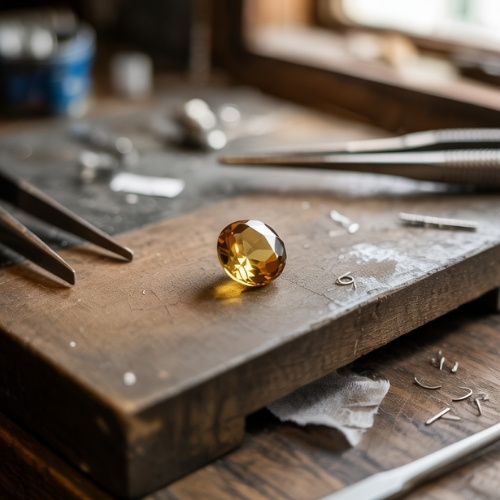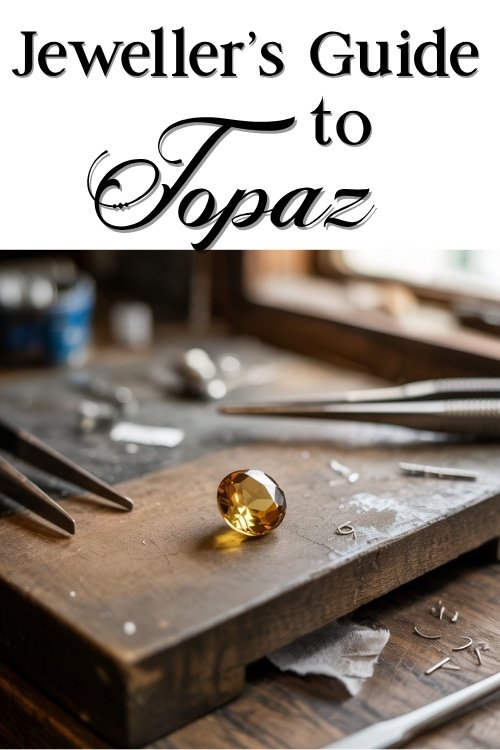Estimated reading time: 5 minutes
From warm golden hues to icy blues and even blush pinks, topaz has a little something for everyone. Whether you’re creating a show-stopping cocktail ring or a dainty charm necklace, this gemstone adds an air of elegance to any design.
Jump to:
Basic Identification Information
Name & Synonyms
Topaz
“Imperial topaz” refers to the prized golden-orange to reddish-pink variety.
Species
Topaz
Colour Range
Colourless, blue, yellow, orange, pink, purple, red, and brown.
Refractive Index
1.609–1.643
Birefringence
0.008 to 0.011
Optical Sign
Biaxial +
Pleochroism
weak to moderate strength. Most topaz show 3 colours, but some only have 2.
Dark Yellow: Citron yellow, honey yellow, and straw yellow.
Yellow: Brownish yellow, yellow, and orange-yellow.
Pale Blue: Blue, pale rose, and colorless.
Brown: Yellow-brown, yellow-brown, and weak yellow-brown.
Green: Colorless to blue-green, green to bright blue-green, and colorless to bright green.
Rose-pink: Yellow, purple, and lilac.
Dark Rose-red: Red to dark red, yellow to honey yellow, and rose red.
Red Topaz: Light red and yellow.
Specific Gravity
3.49–3.57
Fluorescence
None to weak
Lustre
Vitreous (glass-like)
Clarity
Type I
Typically eye clean, visible inclusions are rare in faceted stones.
Gems Often Mistaken For
Citrine, Aquamarine, Spinel, Sapphire, Clear Quartz
Mohs Hardness
8
Wearability
Very good, but cleavage makes it vulnerable to splitting under sharp impact.
Birthstone
November (along side citrine)
Spotting Synthetic (Lab-Grown) Topaz
Lab-grown topaz is extremely rare. Most synthetic or imitation topaz in the market is actually a simulant, such as coloured glass or synthetic quartz, rather than a true synthetic version of topaz.
Common Treatments
Topaz is often treated to enhance or alter its colour, and these enhancements are widely accepted within the gem trade. The most common example is blue topaz, which is typically produced by irradiating colourless topaz and then heating it. This process results in vibrant shades like Sky Blue, Swiss Blue, and London Blue.
Pink topaz is usually created by heat-treating yellow or brownish stones to achieve a softer, more desirable hue. This treatment is also considered stable and permanent under normal wear conditions.
Mystic topaz, on the other hand, is a surface-treated stone. A thin metallic coating, often titanium, is applied to colourless topaz to produce an iridescent, rainbow-like effect. While striking, this coating is delicate and can scratch or wear off over time, especially on rings or bracelets that see frequent use.
Durability & Setting Considerations
While topaz ranks high in hardness, it has perfect cleavage, meaning it can split if struck in the wrong direction. This makes it slightly fragile in rings and other high-contact pieces.
Protective settings such as bezels or halos are recommended, particularly for statement jewellery, bracelets and rings.
Avoid casting around topaz, as it can be damaged by extreme heat. Always set after all heat work has been completed.
🛍️ Explore our selection of pre-owned Topaz Gemstones for your next jewellery creation.
Care Instructions
Cleaning
Use warm water, mild soap, and a soft brush or cloth. Avoid ultrasonic and steam cleaners, which can damage or alter treated stones.
Storage
Store pieces separately in soft-lined compartments or pouches to prevent scratching, especially important for coated topaz like mystic topaz.
Daily Wear
Although suitable for regular use, topaz should be worn with care. Remove during sports or household tasks, and keep away from prolonged sunlight, which may fade its colour over time.
Market & Ethical Notes
Topaz is widely available and generally affordable, particularly blue varieties, which are mass treated and abundant. In contrast, Imperial topaz is rare and valuable, especially in reddish hues.
Brazil remains the primary source of topaz, with other notable sources including Russia, Pakistan, and Sri Lanka.
Ethical sourcing is typically less of a concern with topaz compared to more controversial gems, though supplier transparency is always encouraged.
🔗 Learn more about the ethical and environmental story behind Reclaimed and Recycled Gemstones.
Symbolic & Spiritual Meanings
Topaz has long been associated with clarity, manifestation, and self-expression. In crystal healing, blue topaz is thought to support communication and truth, while Imperial topaz symbolises abundance, creativity, and personal power.
This gem is also said to strengthen confidence and bring joy, making it a symbolic match for both designers and wearers seeking a touch of inspiration.
🔗 Dive deeper into Topaz’s Symbolic & Spiritual Meanings
Etymology
The word topaz likely comes from the ancient Greek Topazios, a Red Sea island (now called Zabargad) once thought to be a topaz source, though it was more likely mining peridot. Another possible origin is the Sanskrit word tapas, meaning “fire” or “heat,” which aligns with the gem’s warm, golden glow.
Historically, the name topaz was used to describe many yellow gemstones before the term was narrowed to this specific species.
🔗Curious about how topaz was viewed in ancient cultures? Explore Topaz Myths and Legends
📌 Save this jeweller’s guide to topaz for quick reference next time you’re working with this stunning gem.


